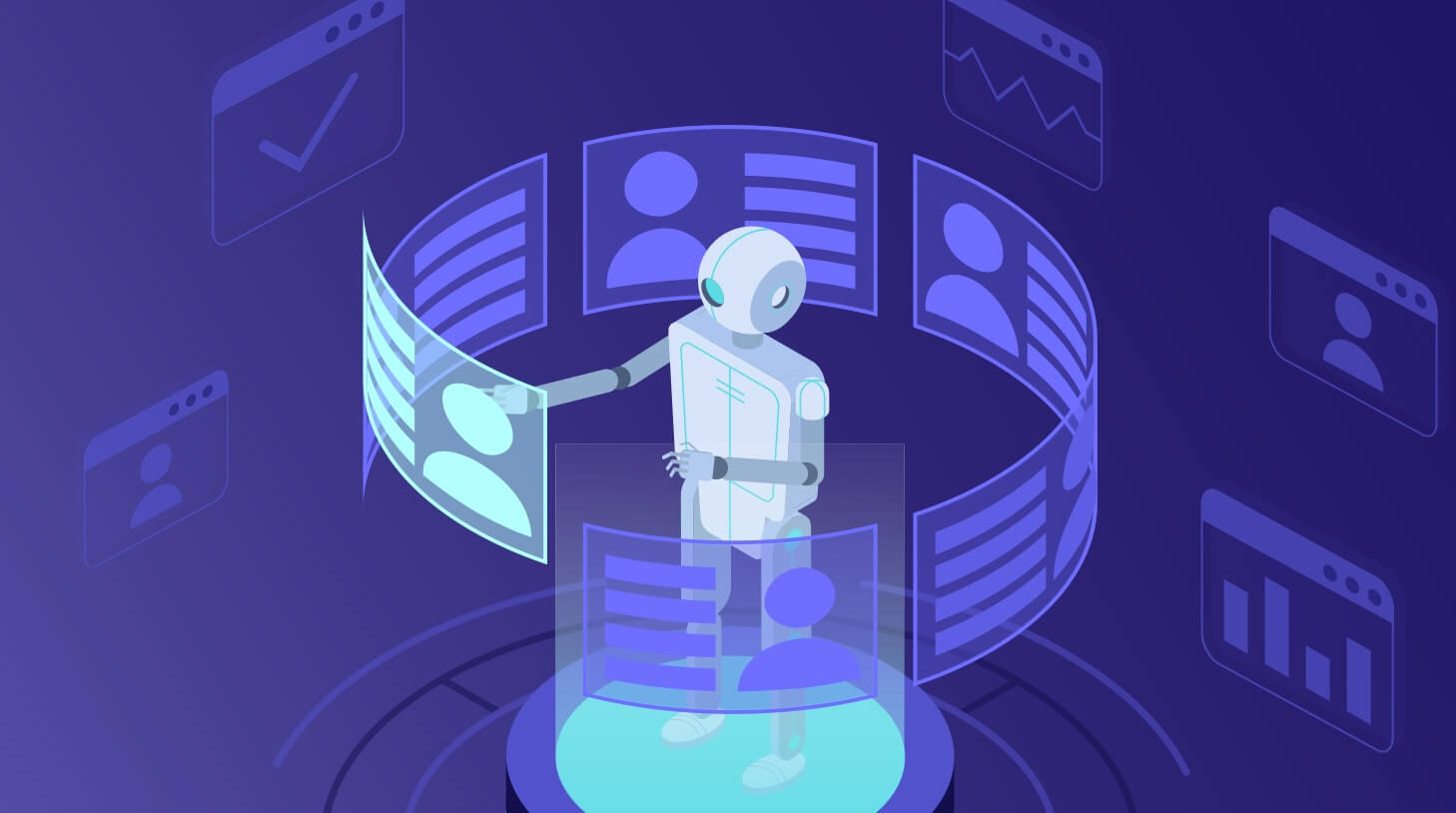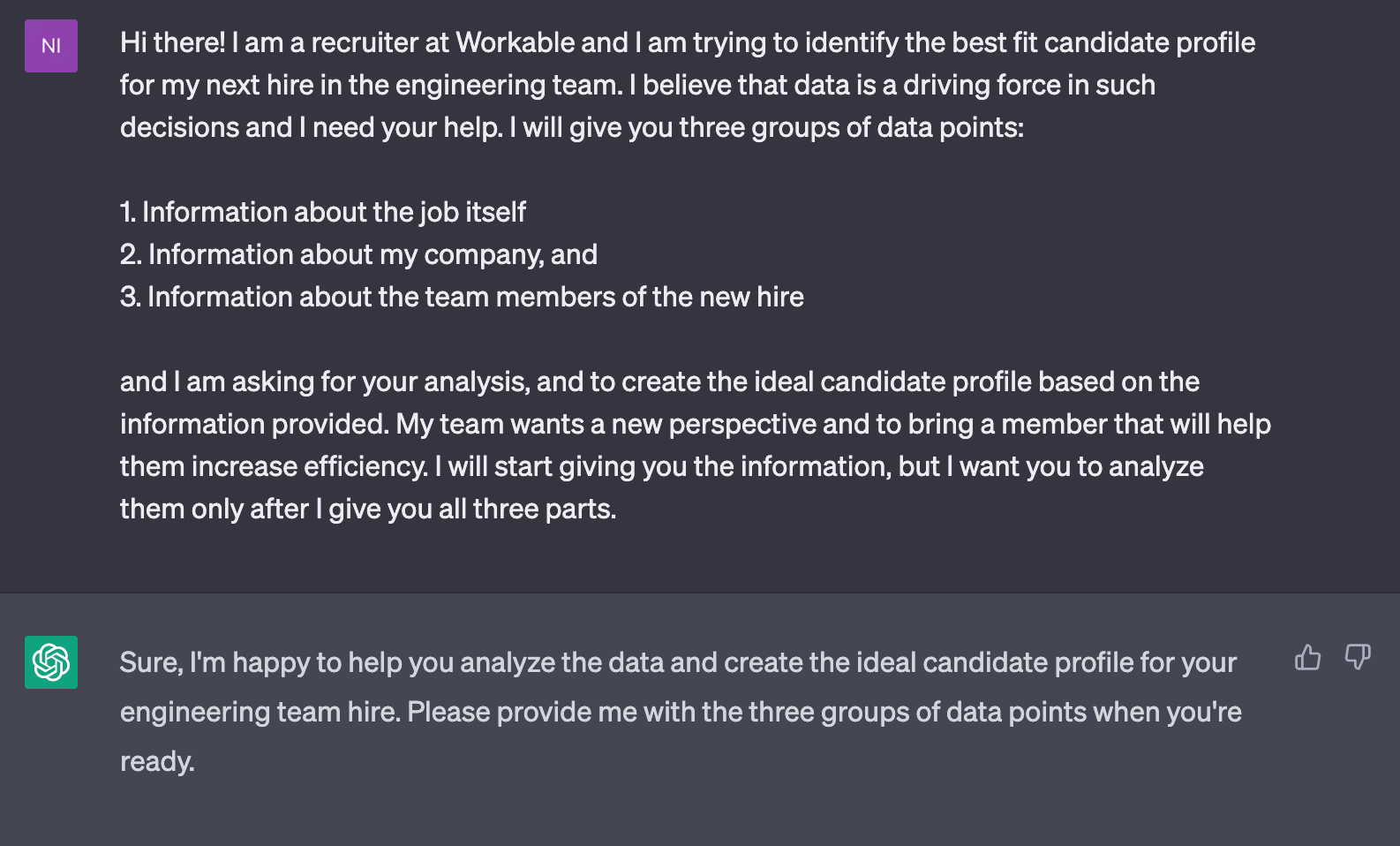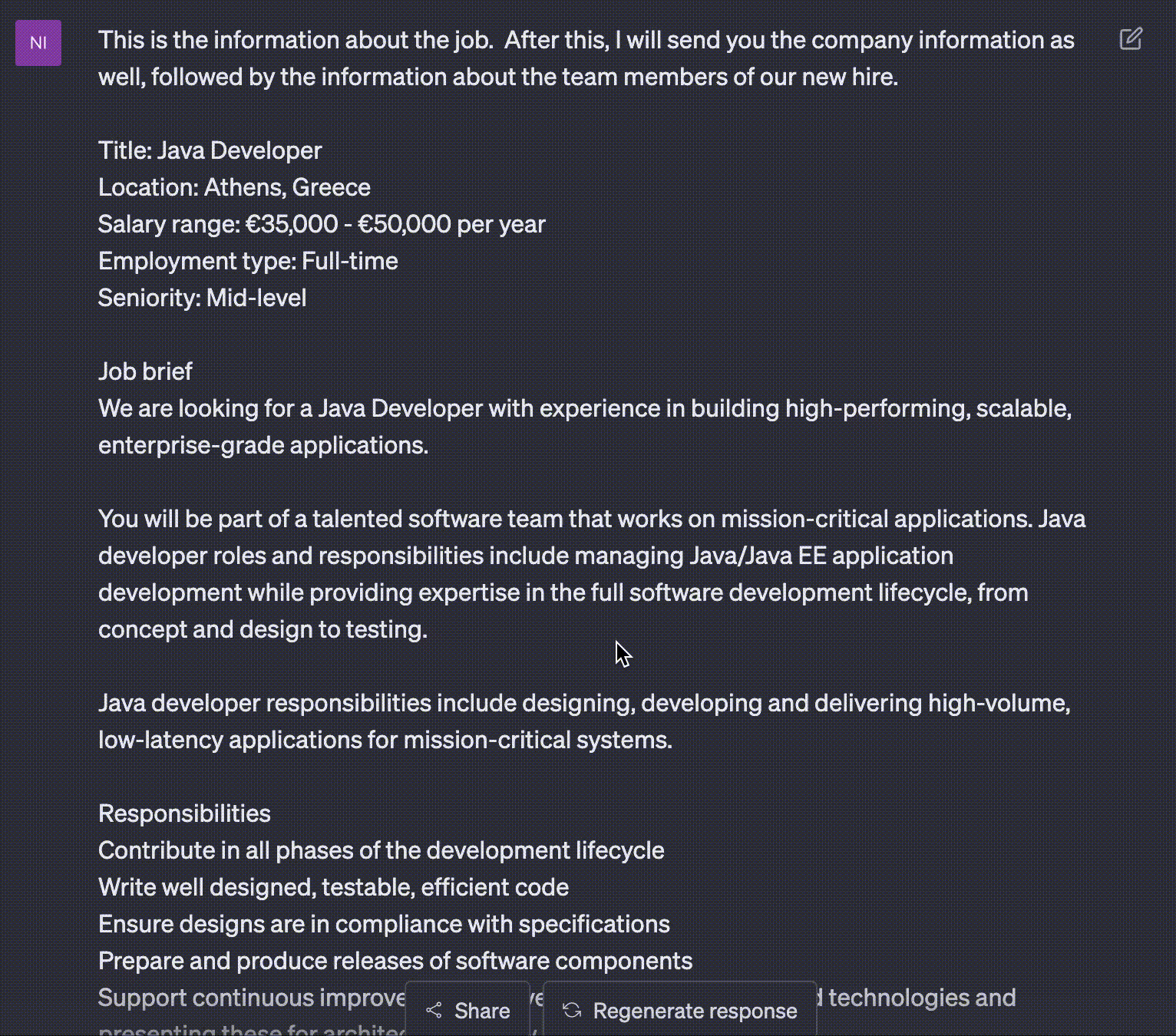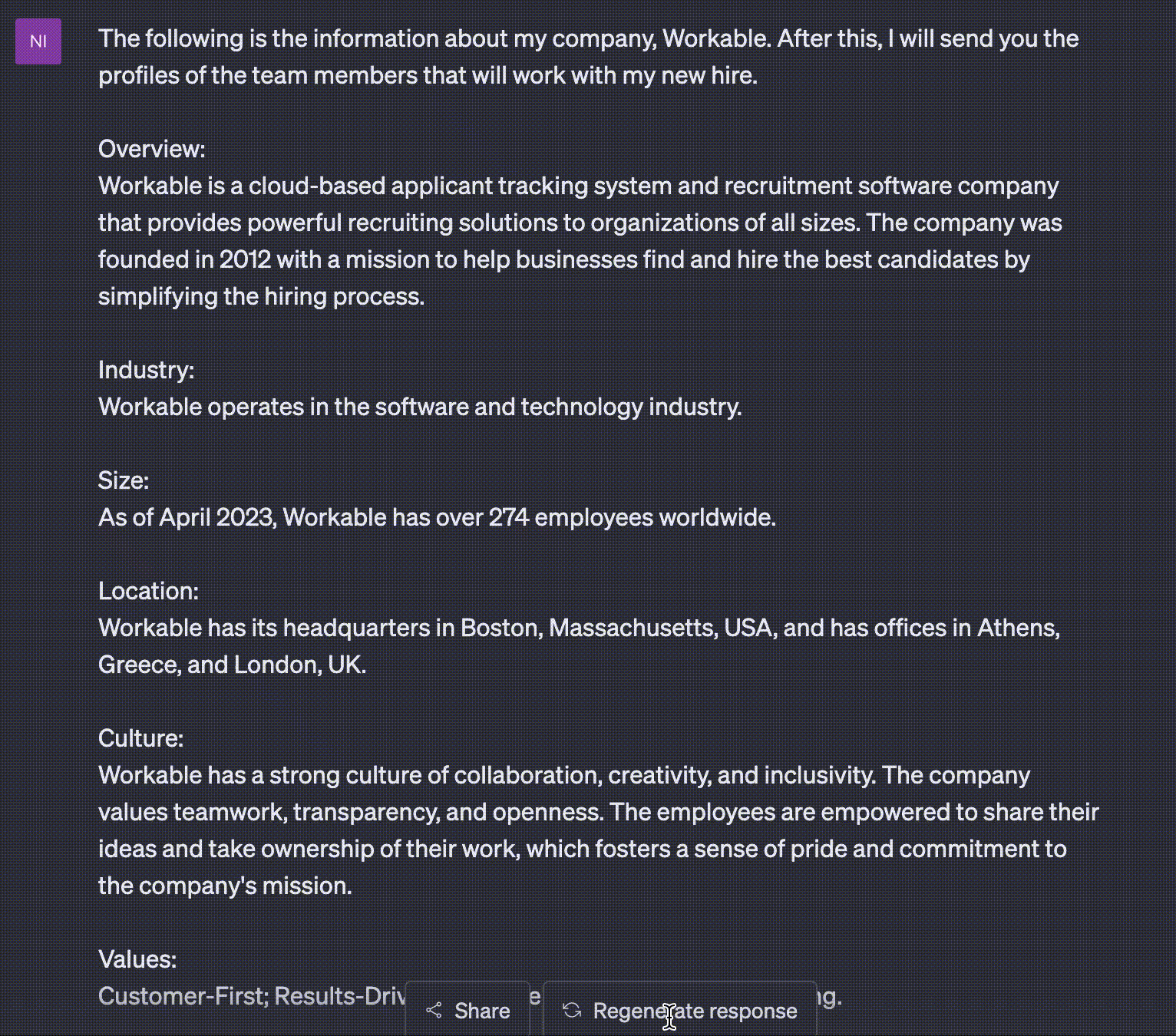Data-driven hiring with ChatGPT: create an ideal candidate profile
Explore how ChatGPT, an AI language model, can be used to create an ideal candidate profile (ICP) to support your hiring process. See examples of how prompt engineering can be used to give ChatGPT information about job descriptions, company culture and team dynamics. The result is an ICP that includes technical skills, soft skills and personality traits that can guide hiring decisions.

Product update – People Search / AI Recruiter is now called Search with AI. Learn more about it here.
Let’s face it – hiring is not easy. From my hundreds of discussions with recruiting teams, I’ve come to this conclusion: hiring is like a box of chocolates – you never know what you’re going to get!
On a more serious note, many SMBs are facing the challenge of finding the right fit for a new hire. These aren’t uncommon challenges for big tech companies either, but the resulting cost of turnover impacts SMBs far more than enterprises due to limited budget.
When talking about why these challenges persist, I consider one of three scenarios:
- You hire someone who ends up falling short on the requirements for the role
- You hire someone that although qualified, is not aligned with the company’s culture or values
- You hire someone who is great for the role, aligned with the company, but does not match their team members.
In any of these cases, you find yourself going back to the drawing board and creating a plan to find the next best person to hire. That quickly becomes expensive.
What’s interesting is that SMBs are also usually the most creative and revolutionary – in other words, agile – when it comes to hiring processes, so, shouldn’t that be a huge benefit? Perhaps, but data is ultimately the driving force for better hiring decisions.
No one likes new hire turnover, or any turnover for that matter – especially when they are costly. In today’s digital age, data has outrightly become the lifeblood of business decisions, and hiring is no exception.
Contents
Using ChatGPT to create an ideal candidate profile
My understanding from seeing the above issues unfold, and discussing them every time I shared demos of Workable with potential clients over the past two years, is that hiring teams can consider analyzing a complicated set of data points and indicators about:
- the job
- the company
- the team members that will work with that new hire
If hiring teams can tangibly analyze data points around these areas, they can make better hiring decisions for the job they’re hiring for. The result? Better engagement, longer tenures, higher productivity, and a lot more.
That’s where ChatGPT and AI can help. As a novice yet excited user of the technology, I turned to prompt engineering with ChatGPT to see if AI can gather the information on all of the above areas in order to analyze and create an ideal candidate profile for the new hire. (You can also make a copy of this prompt guide for your own use later).
Hi there! I am a recruiter at Workable and I am trying to identify the best fit candidate profile for my next hire in the engineering team. I believe that data is a driving force in such decisions and I need your help. I will give you three groups of data points:
1. Information about the job itself
2. Information about my company, and
3. Information about the team members of the new hire
and I am asking for your analysis, and to create the ideal candidate profile based on the information provided. My team wants a new perspective and to bring a member that will help them increase efficiency. I will start giving you the information, but I want you to analyze them only after I give you all three parts.
And it worked. Let’s go through these next steps one by one.
1. The job
Let’s start with the job description itself. To explore the potential of AI in creating an ideal candidate profile, I started by providing ChatGPT with job information. I included the job title, location, salary range, employment type, seniority, and a brief description of the job. For this example, I used the Java Developer job description from Workable’s template library.
Forget about AI and ChatGPT for a minute: in plain hiring, the job description provides the context for what we are looking for, the skills required, and the responsibilities the candidate would undertake. When we publish that job, we either wait for candidates to apply, proactively source candidates with tools such as AI Recruiter, share the job posting with an agency, and so on.
In the first case, you are giving control to the candidates in deciding whether to apply. In the second case, you’re using keywords to find candidates. In the third case, you’re sharing the job description with the agency who helps you find candidates.
It’s the same case with ChatGPT, except the communication is via prompts.
I chose a structured format when prompting ChatGPT about the job. But even if you wrote a paragraph prompt, AI is smart enough to get the context of what you need.
This is the information about the job. After this, I will send you the company information as well, followed by the information about the team members of our new hire.
{Add job information here}
Do not analyze the information just yet, wait till I give you the next parts.
I also asked ChatGPT not to analyze this data set yet, but wait for me to give more information and direction.
You then share the job description itself. But hold on: while ChatGPT now knows what job you’re hiring for, is that enough?
No.
A job exists within a company, and people work with people, so we’re missing some important parts. Let’s move on now that ChatGPT has the job description in its repertoire.
2. The company
Prompt engineering works best in parts. You don’t want to overwhelm ChatGPT with all kinds of information at once. So, once you’ve given it the job description, you then share the company information.
This is important, because finding the right candidate means not only finding someone who is capable of doing the job, but also someone who shares the same values and vision as the company.
After all, the ideal candidate would be someone who is not only productive but also passionate about what they do, and who would contribute to the company’s growth and success in the long run.
That’s why you need to share company details. To get started, I gave ChatGPT some basic company information such as the size, industry and location of the company. I also provided more specific details about the company’s mission, culture and values.
Then, because employee reviews affect candidate choices, I added some testimonials as well, and finished with a link to the company’s careers page. These were things that were not easy to quantify, but I believed they were crucial in understanding the type of person who would thrive in this environment.
In this case, I am using Workable as an employer. All the information above can be found in our publicly accessible employee handbook. Again, structured format is important for me, but you can also choose how you prompt ChatGPT.
The following is the information about my company, Workable. After this, I will send you the profiles of the team members that will work with my new hire.
{Add company information here}
Do not analyze the data just yet; wait till I give you everything else.
As you see, I had to remind ChatGPT to not analyze the data and respond just yet, but to continue to wait until after I share the next set of data.
Okay, now ChatGPT has the job and the company information. This is the easy part. We all have a description, and we all know about our company.
Yet, again, I still felt this was not enough. We are still missing a crucial part, that of the team members the new hire will work with, and the dynamics between them. After all, people work with people (at least for now), so we need to add that important piece to the puzzle.
3. The team
When you hire someone, you’re not just looking for a candidate who’s qualified and fits the company culture, but also someone who will thrive and collaborate with existing team members.
By adding profiles of current team members to the mix, I hoped to give ChatGPT enough context that could help create an ideal candidate profile that would fit seamlessly within the existing team dynamic.
The tough part here is, what do I include about each team member? Also, how easy is it to gather such information for my prompt? I had to think on this a bit, but was able to conjure up the following factors for each team member to get started:
- Role within the team
- Specific job duties and responsibilities
- Skills and qualifications required for the job
- Experience level
- Training and development needs
- Challenges with other members
- Individual satisfaction levels and potential retention challenges
- Personality traits and T-scores (if applicable)
- Performance metrics from last year
- Collaboration and communication style
The more specific details the merrier, as ChatGPT will have an enhanced prompt about the team members the new hire will work with in designing the ideal candidate profile for you.
For lack of time and gathering this information myself, and because I was eager to get to the finish line, I asked ChatGPT to create three team members of an engineering team (Junior, Senior, VP of Engineering) based on these factors, so I can use those to enter into ChatGPT.
You can do this too. It’s just an example, but it can also be helpful when you’re building a new team from scratch.
These are the full profiles for the three (3) members the new hire will work with. I am sharing them all together so you can analyze faster. Each new member profile starts with Team Member X, where X is the number (X = 1, 2, 3, etc.). This is also the last data set, so you can analyze and give me the ideal candidate profile for our new hire.
{Team Member 1 Information}
{Team Member 2 Information}
{Team Member 3 Information}
Perfect! Now ChatGPT has details on the job, the company, and the team. Time to analyze!
4. The ideal candidate profile
I decided the ideal candidate profile should have three parts: technical skills and competencies, soft skills, and personality. I asked ChatGPT to rewrite the profile analysis in these parts. I asked for specific insight into the technical skills, the personality traits (including an approximate T-Score range to aim for on a Big 5 personality profile), and the soft skills.
I also hinted that, for this hire, my team wants a fresh perspective and has a goal to increase efficiency across the board.
This is great! Now, I want this ideal candidate profile to be easily readable and split in three parts:
1. The technical skills and competencies
2. The soft skills, and
3. The personality
Would be great if you can create such a profile, based on the information I have given you, with this format. For the personality, feel free to share a Big 5 personality profile, and include some indicative T-score average ranges.
And ChatGPT learned! It picked it up by itself, in itself, and kept getting better as I asked it more questions and made more requests to refine the ICP. My experiment worked.
Use ChatGPT to create your own ICP
Well, this was a fun conversation with ChatGPT, don’t you think? And ultimately, it helped answer a dilemma in my head about whether we can use AI to help us make better, data-driven hiring decisions.
It’s important to maintain the human touch in the selection process, however. The final decision is up to you as the hiring manager and/or the recruiter. Now that you have an ideal candidate profile thanks to prompt engineering ChatGPT with precise information about the job, context about the company, and a thorough profile of the team members for your new hire, you can use it to guide your decisions. The data you fed into ChatGPT proves to indeed be an effective way to find the right candidate for a job opening.
Why did I use ChatGPT? Because it’s a time and resource saver. This process would have taken weeks of research, hours of compiling, and a lot of energy to do alone – with ChatGPT, I had my ideal profile fully built out in minutes.
With that ICP ready, ChatGPT was even able to provide the following with a mere prompt:
- Boolean strings that could be used for sourcing tools, allowing for more efficient and targeted candidate searches
- Analysis of company culture and values, which are important considerations for finding a candidate who will not only be productive but also passionate about their work and contribute to the company’s long-term success
- Insights into the existing team dynamics, and each member’s goals, responsibilities, and personality, in order to design a candidate profile that can thrive in this environment
If by using this process, one can help reduce new hire turnover and save their company costs, that is a clear win in itself. Of course, this process can be refined, although there is no perfect way to do it. Likewise, even with access to extensive data and a candidate profile like the one just created, there is no such thing as a “perfect” candidate. And, again, the final decision ultimately rests with the actual humans in the hiring team – as it should.
Watch this space for more guides on using ChatGPT to determine what job, company and team member information gives the best results when used as prompts. And of course, I’m using ChatGPT itself to help me do so. Stay tuned!
Frequently asked questions
- What is ChatGPT and how can it be used in hiring?
- ChatGPT is an AI language model that can be used to analyze job descriptions, company culture and team dynamics to create an ideal candidate profile (ICP). The ICP includes technical skills, soft skills and personality traits, which can guide hiring decisions.
- How does prompt engineering work with ChatGPT in hiring?
- Prompt engineering involves providing ChatGPT with specific information about a job description, company culture and team dynamics in a structured format. This information is used to create an ICP that can guide hiring decisions.
- What are the benefits of using ChatGPT for hiring?
- Using ChatGPT can save time and resources by creating an ideal candidate profile quickly and efficiently. It can also provide insights into company culture and team dynamics that can guide hiring decisions and reduce new hire turnover.
- Is ChatGPT a replacement for human recruiters or hiring managers?
- No, ChatGPT is not a replacement for human recruiters or hiring managers. The final hiring decision still rests with humans, but ChatGPT can help guide those decisions by providing data-driven insights.
- How can companies get started with using ChatGPT for hiring?
- Companies can get started with using ChatGPT for hiring by providing specific information about job descriptions, company culture, and team dynamics in a structured format. This information can be used to create an ICP that can guide hiring decisions. It's important to remember that ChatGPT is a tool, and the final hiring decision still rests with humans.









